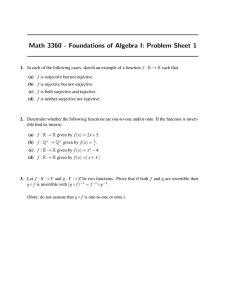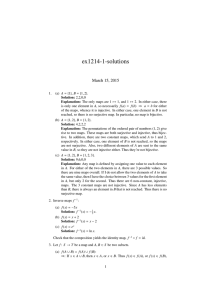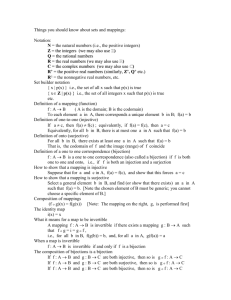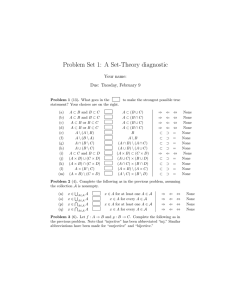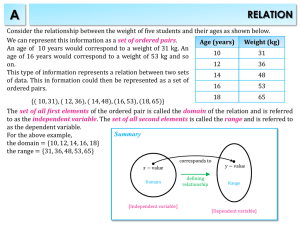Injective, Surjective, and Bijective Functions Paul Skoufranis September 28, 2015
advertisement
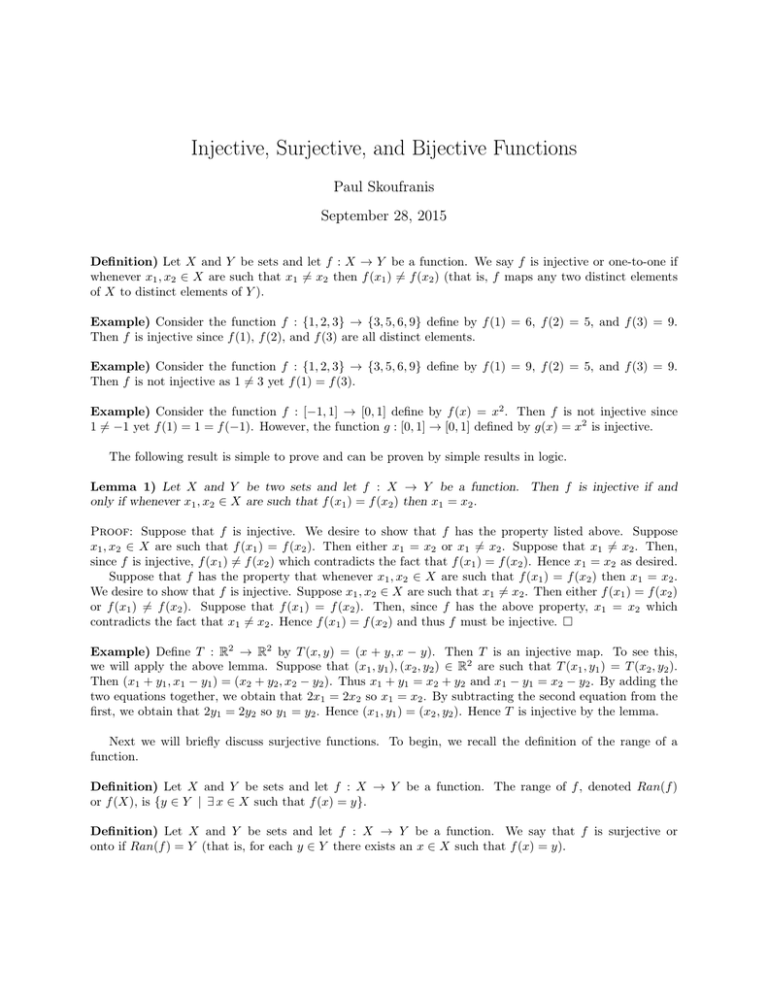
Injective, Surjective, and Bijective Functions
Paul Skoufranis
September 28, 2015
Definition) Let X and Y be sets and let f : X → Y be a function. We say f is injective or one-to-one if
whenever x1 , x2 ∈ X are such that x1 6= x2 then f (x1 ) 6= f (x2 ) (that is, f maps any two distinct elements
of X to distinct elements of Y ).
Example) Consider the function f : {1, 2, 3} → {3, 5, 6, 9} define by f (1) = 6, f (2) = 5, and f (3) = 9.
Then f is injective since f (1), f (2), and f (3) are all distinct elements.
Example) Consider the function f : {1, 2, 3} → {3, 5, 6, 9} define by f (1) = 9, f (2) = 5, and f (3) = 9.
Then f is not injective as 1 6= 3 yet f (1) = f (3).
Example) Consider the function f : [−1, 1] → [0, 1] define by f (x) = x2 . Then f is not injective since
1 6= −1 yet f (1) = 1 = f (−1). However, the function g : [0, 1] → [0, 1] defined by g(x) = x2 is injective.
The following result is simple to prove and can be proven by simple results in logic.
Lemma 1) Let X and Y be two sets and let f : X → Y be a function. Then f is injective if and
only if whenever x1 , x2 ∈ X are such that f (x1 ) = f (x2 ) then x1 = x2 .
Proof: Suppose that f is injective. We desire to show that f has the property listed above. Suppose
x1 , x2 ∈ X are such that f (x1 ) = f (x2 ). Then either x1 = x2 or x1 6= x2 . Suppose that x1 6= x2 . Then,
since f is injective, f (x1 ) 6= f (x2 ) which contradicts the fact that f (x1 ) = f (x2 ). Hence x1 = x2 as desired.
Suppose that f has the property that whenever x1 , x2 ∈ X are such that f (x1 ) = f (x2 ) then x1 = x2 .
We desire to show that f is injective. Suppose x1 , x2 ∈ X are such that x1 6= x2 . Then either f (x1 ) = f (x2 )
or f (x1 ) 6= f (x2 ). Suppose that f (x1 ) = f (x2 ). Then, since f has the above property, x1 = x2 which
contradicts the fact that x1 6= x2 . Hence f (x1 ) = f (x2 ) and thus f must be injective. Example) Define T : R2 → R2 by T (x, y) = (x + y, x − y). Then T is an injective map. To see this,
we will apply the above lemma. Suppose that (x1 , y1 ), (x2 , y2 ) ∈ R2 are such that T (x1 , y1 ) = T (x2 , y2 ).
Then (x1 + y1 , x1 − y1 ) = (x2 + y2 , x2 − y2 ). Thus x1 + y1 = x2 + y2 and x1 − y1 = x2 − y2 . By adding the
two equations together, we obtain that 2x1 = 2x2 so x1 = x2 . By subtracting the second equation from the
first, we obtain that 2y1 = 2y2 so y1 = y2 . Hence (x1 , y1 ) = (x2 , y2 ). Hence T is injective by the lemma.
Next we will briefly discuss surjective functions. To begin, we recall the definition of the range of a
function.
Definition) Let X and Y be sets and let f : X → Y be a function. The range of f , denoted Ran(f )
or f (X), is {y ∈ Y | ∃ x ∈ X such that f (x) = y}.
Definition) Let X and Y be sets and let f : X → Y be a function. We say that f is surjective or
onto if Ran(f ) = Y (that is, for each y ∈ Y there exists an x ∈ X such that f (x) = y).
Example) Consider the function f : {1, 2, 3, 4} → {3, 5, 9} define by f (1) = 3, f (2) = 5, f (3) = 9,
and f (4) = 5. Then f is surjective since the range of f is the entire set {3, 5, 9}.
Example) Consider the function f : {1, 2, 3, 4} → {3, 5, 9} define by f (1) = 9, f (2) = 5, f (3) = 9,
and f (4) = 5. Then f is not surjective since 3 is not in the range of f .
Example) Consider the function f : [0, 1] → [0, 2] define by f (x) = x2 . Then f is not surjective since
2∈
/ Ran(f ). However, the function g : [0, 1] → [0, 1] defined by g(x) = x2 is surjective.
Example) Define T : R2 → R2 by T (x, y) = (x + y, x − y). Then T is a surjective map. To see this,
suppose (z, w) ∈ R2 . Then, since
z+w z−w
,
= (z, w)
T
2
2
(z, w) ∈ Ran(T ) (the range of a linear map is also called the image). Hence, as (z, w) ∈ R2 was arbitrary,
Ran(T ) = R2 so T is surjective.
Finally, we may begin our discussion of bijective functions.
Definition) Let X and Y be sets and let f : X → Y be a function. We say that f is bijective if it is
injective and surjective.
Example) Define T : R2 → R2 by T (x, y) = (x + y, x − y). We have shown that T is injective and
surjective. Hence T is bijective.
Example) Consider the function f : N → N ∪ {0} defined by f (n) = n − 1. We claim f is a bijection.
To see that f is injective, we must show that if n, m ∈ N are such that f (n) = f (m) then n = m. Suppose
n, m ∈ N are such that f (n) = f (m). Then n − 1 = f (n) = f (m) = m − 1. Therefore n − 1 = m − 1 so
n = m. Hence f is injective.
To see that f is surjective, we must show that for every k ∈ N ∪ {0} there exists a n ∈ N (depending on
k) such that f (n) = k. Suppose k ∈ N ∪ {0}. Then k + 1 ∈ N. Moreover f (k + 1) = (k + 1) − 1 = k. Whence
f is surjective. Hence f is a bijection.
Bijective maps have some very nice properties. First we will show that if f : X → Y is a bijection then
there is a function g : Y → X that ’undoes’ what f does.
Theorem 2) Let X and Y be two sets and suppose f : X → Y is a bijection. Then there exists a
unique function g : Y → X such that
1. g(f (x)) = x for all x ∈ X.
2. f (g(y)) = y for all y ∈ Y .
The function g is called the inverse of f and is denoted f −1 .
Proof: Let X and Y be two sets and suppose f : X → Y is a bijection. There are two parts to this
proof: show that there exists a function g : Y → X with the above properties, and show that there exists
only one function g with these properties. Thus we will split the proof into two parts.
First we desire to show that there exists a g with the two properties above. Therefore, for each y ∈ Y
we need to define g(y) to be an element of X. Since f is bijective, Ran(f ) = Y . Therefore for each y ∈ Y
there exists at least one point xy ∈ X such that f (xy ) = y. We then define g(y) = xy for all y ∈ Y . Hence
g : Y → X is a function.
It remains to check that g has the above two properties. To see that g has the first property, suppose
z ∈ X. Since z ∈ X, f (z) ∈ Y and thus, by the definition of xf (z) , g(f (z)) = xf (z) . We desire to show that
2
g(f (z)) = z. We claim that xf (z) = z. To see this, we notice that f (xf (z) ) = f (z) by the definition of xf (z) .
Since f is injective, f (xf (z) ) = f (z) implies xf (z) = z as claimed. Therefore g(f (z)) = xf (z) = z as desired.
To see that g has the second property, we notice that if y ∈ Y then f (g(y)) = f (xy ) = y by definitions.
Therefore g has the second property. Hence g has the two properties.
It remains only to show that g is the only function with the above properties. Suppose g1 : Y → X is
another function such that g1 (f (x)) = x for all x ∈ X and f (g1 (y)) = y for all y ∈ Y . Fix y ∈ Y . Then
f (g1 (y)) = y = f (g(y)). Since f is injective, f (g1 (y)) = f (g(y)) implies g1 (y) = g(y). However, this equation
holds for all y ∈ Y . Hence g = g1 . Thus g is the only function with the above properties. Next we will show properties 1) and 2) of the above theorem implies that the functions under consideration are bijections.
Theorem 3) Let X and Y be two sets and suppose f : X → Y and g : Y → X are functions such
that
1. g(f (x)) = x for all x ∈ X.
2. f (g(y)) = y for all y ∈ Y .
Then f and g are bijections.
Proof: Let X and Y be two sets and suppose f : X → Y and g : Y → X are functions with the above
properties. First we will show that f is a bijection. To see that f is injective, suppose x1 , x2 ∈ X are such
that f (x1 ) = f (x2 ). We desire to show that x1 = x2 . Since f (x1 ) = f (x2 ), x1 = g(f (x1 )) = g(f (x2 )) = x2 .
Whence f is injective. To see that f is surjective, let y ∈ Y . Then g(y) ∈ X and f (g(y)) = y. Whence
f is surjective. Therefore f is bijective. The proof that g is bijective is identical (and can be obtained by
interchanging the roles of f and g with g and f ). To summarize:
Theorem 4) Let X and Y be two sets and suppose f : X → Y is a bijection. Then f −1 : Y → X is
also a bijection. Moreover (f −1 )−1 = f (that is, the inverse of f −1 is f ).
Proof: Suppose f is bijective. Then f −1 : Y → X satisfies the properties that f −1 (f (x)) = x and
f (f −1 (y)) = y for all x ∈ X and y ∈ Y . Hence f −1 is bijective by the above theorem.
To see that (f −1 )−1 = f we notice that, since f −1 : Y → X is bijective, (f −1 )−1 exists and (by a previous
theorem) is the unique function such that (f −1 )−1 (f −1 (y)) = y for all y ∈ Y and f −1 ((f −1 )−1 (x)) = x for
all x ∈ X. Since f (f −1 (y)) = y and f −1 (f (x)) = x for all x ∈ X and y ∈ Y , the uniqueness of the function
(f −1 )−1 implies (f −1 )−1 = f as desired. Challenging Exercises)
1. Show that there exists a bijective function f : N → Q.
2. Show that if f : N → R, then f is not a bijection.
Extremely Challenging Exercise)
Let A and B be two sets. Suppose there exists subsets A1 ⊆ A and B1 ⊆ B and bijective functions
f : A → B1 and g : B → A1 . Prove there exists a bijective function h : A → B.
3


